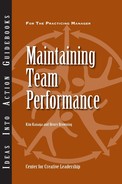Reading the Signals

The six dimensions of effectiveness provide a broad overview of team performance. They give team leaders a kind of maintenance manual, which they can use to monitor their team’s work. But sometimes the underlying problem is harder to see. Even with consistent monitoring, difficulties can crop up that hinder a team. CCL’s work with teams in scores of organizations reveals that there are four key indicators of trouble. Think of these indicators as gauges on a car. If the oil pressure light comes on, for example, that may indicate low oil, or something more serious, like a leaking gasket. If the engine temperature gauge rises above the normal range, you know to pull over and not to wait until steam is pouring out from under the hood of the car. The four indicators that a team is in trouble – lack of effort, missing knowledge/skills, unsuitable tactics, and negative group dynamics – are diagnostic tools that help team leaders locate problems before they turn into disasters.
Effort
This indicator relates to the extent to which team members devote sufficient time and effort to the task. If your team is working effectively, members devote enough of their time to the work of the team, they apply their effort and talent to the team’s work, they rarely allow themselves to be distracted from performing their tasks, and, if they do get sidetracked, members quickly realize and evaluate their situation and get back to the main task without delay or strife.
Knowledge and Skills
This indicator describes the degree to which the team possesses the competencies and ability to do the work. In a high-performing team, members have the requisite knowledge and skills to do the task, the team is confident that it can do a quality job without the guidance of outside experts, and, when there is a gap, members have the ability and opportunity to acquire the needed knowledge and skills.
Tactics
In teams that are effective, members use appropriate tactics to accomplish team goals. The team usually talks about how to approach specific tasks; members and stakeholders see the team’s tactics as rational, logical, and direct; and, when an unusual challenge presents itself, the team creates new ways of handling it. The team will also review its methods and make any needed changes.
Group Dynamics
This indicator refers to the extent to which the team accomplishes its work without undue friction or waste. It sees conflict as an opportunity to gain new information and different perspectives. In a team that is working well, members exhibit a high level of emotional maturity and interpersonal skills. Interpersonal relationships don’t detract from but contribute to accomplishing team goals. The team employs a variety of effective decision-making processes, conflicts are resolved, and team members enjoy working together.
Effort. You often can see when effort becomes an issue for your team. Members lack urgency and focus. They are easily distracted and often go on tangents, rather than staying on task.
Knowledge and skills. You can often hear if your team has a knowledge or skill problem. Members will say such things as “How do we do that?” “Has anyone seen this before?” “What do we do next?” When team members sound lost, suspect that knowledge and skills are missing.
Tactics. Unsuitable tactics frequently smell funny. Observing a team tactic or process, you might scrunch up your nose and wonder, “Why did they do it that way?” or “That seems like a roundabout way to solve that problem.”
Group dynamics. If there’s a problem with group dynamics, you will probably feel it. Team meetings will make you physically uncomfortable. You will feel the tension and conflict in the room. You will feel people trying to dominate and control others.
